Leah A. answered • 05/24/19
EMT and Nursing Student - In-Depth Anatomy Applications
- Ca+2 is released from the terminal cisternae of the sarcoplasmic reticulum
- Ca+2 binds to active site on troponin, which moves the tropomyosin complex and exposes binding sites of actin.
- Attached to the head of myosin, an ATP molecule is hydrolyzed, causing the "flexing" of the myosin head
- Myosin heads bind to the active sites of actin (also known as the cross-bridge)
- The power stroke - myosin heads "pull" the actin towards the center of the sarcomere; ADP is released from the myosin
- **The myosin heads remain attached until a fresh ATP comes along.**
- ATP causes the myosin head to be released by binding to the myosin head
- ATP is hydrolyzed and re-energizes the myosin head
- Ca2+ is pumped back into the terminal cisternae
Explanation:
We should know that muscles are made up cells called muscle fibers. These muscle fibers, like all cells, have a cell membrane, an endoplasmic reticulum, and cytoplasm. In a muscle cell, they just get fancy names. Cell membrane = sarcolemma. Endoplasmic reticulum = sarcoplasmic reticulum. Cytoplasm = sarcoplasm. Inside of the muscle fibers are units called myofibril. These myofibrils contain the repeating units of muscle contraction called sarcomeres. The sarcomeres are made up of myofilaments called actin and myosin. (HINT: A fiber is thicker than a fibril and a fibril is thicker than a filament. That should help you remember that the fibers are made of the fibrils and the fibrils are made of the filaments). Another hint: Actin rhymes with thin! So actin is the thin filament while myosin is the thick filament.
Since we don't want myosin binding to the actin just randomly, wrapped around the actin are troponin and tropomyosin. These are regulatory proteins that control when the myosin can bind to the actin.
Here's a good way to remember the troponin and tropomyosin. Let's think about a tupperware container. When we're not eating out of it or using it, we put a lid on it, right? The tropomyosin is like a "lid" for the actin. When the muscle is not actively contracting, the tropomyosin covers the actin like a "lid". Then, the troponin is similar to those snap-down handles on the tupperware container that help hold the lid in place. The troponin is simply helping the tropomyosin stay on top of the actin.
Before I start explaining the muscle contraction, remember that myosin is bound to the middle of the sarcomere at the M-line while actin is attached to the edges of the sarcomere at the Z-line. **Contraction occurs when the myosin heads pull the actin towards the center of the sarcomere, and thus, the sarcomere shortens**
In order to begin muscle contraction, the muscles have to receive a signal/message! Where does this come from? The nervous system! A motor neuron innervates several muscle fibers. (Think: that the "M" in motor stands for "movement" and "muscles". Motor neurons tell muscles to move). The area where the motor neuron connects/meets the muscle fiber is called the neuromuscular junction. (Junction = area where two people or places meet; neuromuscular = well it's just the neuron + muscle fiber!). At the neuromuscular junction, at the very end of the motor neuron are synaptic bulbs. Neurons do not directly touch/connect to other cells or neurons, and the electrical signal cannot "jump" across to another cell. This means that there has to be some other substance that will carry the signal from the neuron to the next cell. These substances are neurotransmitters. The neurotransmitter involved in somatic (skeletal) motor neurons is acetylcholine. When the electrical signal reaches the end of the axon terminal, it causes Ca+2 channels in the synaptic bulb to open. The entrance of Ca+2 causes vessicles (which you can think of as little water balloons full of neurotransmitter) to start moving towards the edge of the synaptic bulb. Once the vessicles fuse with the edge of the bulb, that releases the neurotransmitter into a space called the synaptic cleft (or synaptic gap). The neurotransmitter will diffuse across the synaptic cleft/gap to receptors on the other cell or neuron, in this case, the sarcolemma of a muscle fiber. When the acetylcholine binds to the receptors on the sarcolemma, this will essentially cause the sarcolemma to become electrically excited/depolarized. The electrical signal spreads/sweeps across the sarcolemma. But then what?
We know that in order for contraction to begin, Ca+2 has to bind to troponin. The concept called excitation-contraction coupling explains how the electrical signal is connected to the release of Ca+2. Ca+2 is stored in the sarcoplasmic reticulum. In order for the electrical signal to get down into the sarcoplasmic reticulum, the electrical signal travels down T-tubules. These T-tubules just carry the electrical signal down to the sarcoplasmic reticulum. The regions of the sarcoplasmic reticulum next to the T-tubule are called terminal cisternae. The electrical signal will cause the terminal cisternae to release calcium. Now we can resume the explanation where the question begins.
The Ca+2 binds to troponin. Troponin helps pull tropomyosin off the actin. The ATP on myosin breaks/hydrolyzes into ADP + P + energy. The myosin head reaches up and forms a cross-bridge with the actin (the connection). The myosin head does the power stroke, pulling the actin towards the center of the sarcomere. The sarcomere shortens from both sides. The ADP + P on the myosin is released. A new ATP must bind to the myosin head in order for it to let go and relax. If Ca+2, O2, and ATP are still present, the muscle can continue to contract. Eventually, Ca+2 is pumped back into the terminal cisternae, the Ca+2 comes off the troponin. The troponin moves the tropomyosin back in place. Myosin can no longer bind to actin, so the muscle relaxes.





